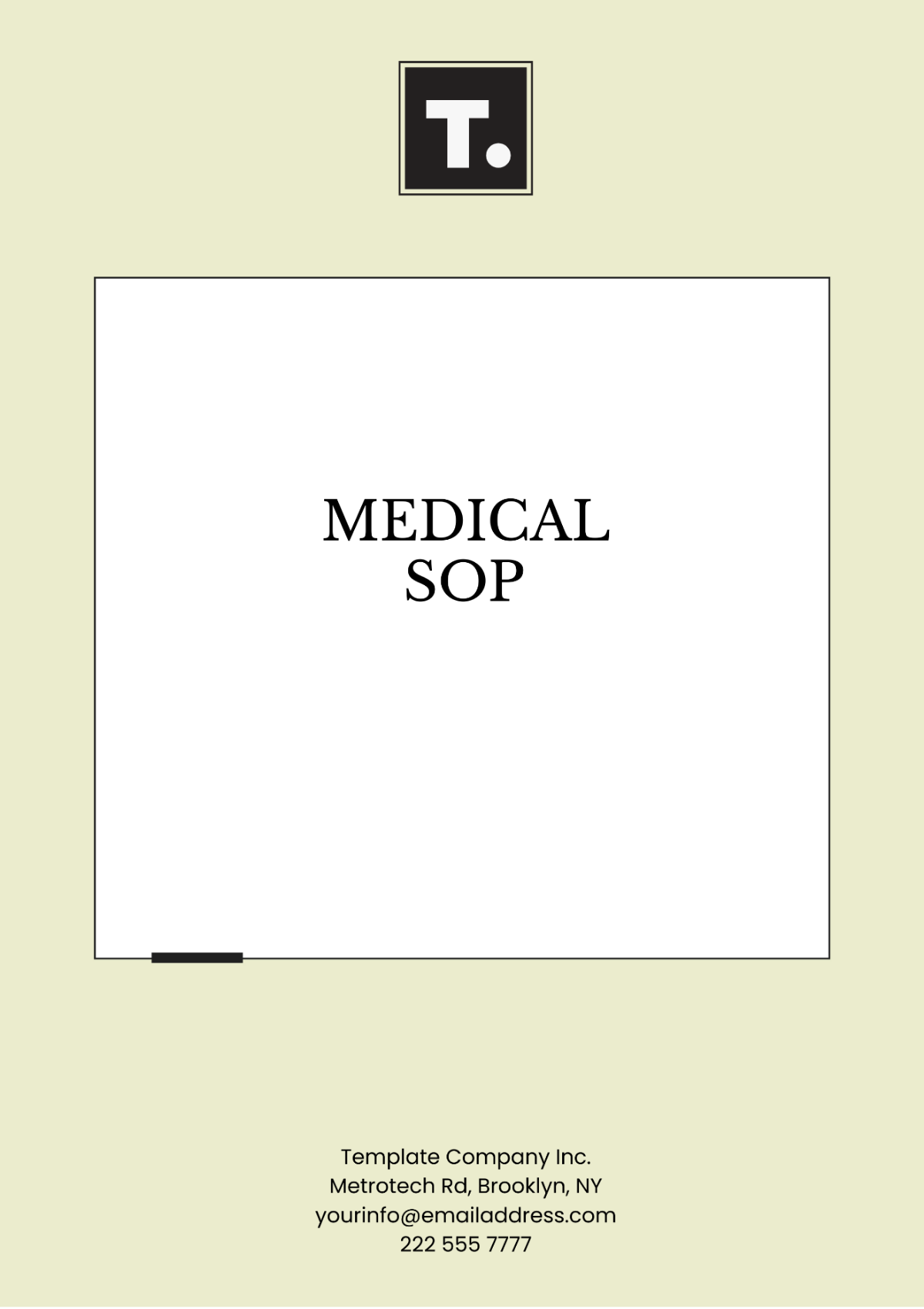Free Medical SOP

I. Objective
The objective of this SOP is to provide detailed guidance and instructions for healthcare professionals at [Your Company Name] on how to perform specific medical tasks and procedures safely and consistently. This SOP aims to ensure quality patient care, adherence to industry standards, and compliance with regulatory requirements.
II. Scope
The SOP under discussion applies to all healthcare employees at [Your Company Name], which includes a diverse spectrum of professionals such as physicians who directly diagnose and treat patients, nurses who facilitate patient care, technicians handling medical machinery and checks, as well as support personnel involved in patient care and medical processes. Every person, independent of their specific function, is mandated to abide by this SOP when working at [Your Company Name], proving the wide scope and relevance of these protocols.
III. Responsibilities
Medical Staff
When performing medical tasks, always adhere to the procedures that are thoroughly detailed and laid out in this Standard Operating Procedure (SOP) document.
Supervisors
It is essential to take certain steps to ensure that all staff members possess not only the necessary training but also the required competence in adhering to and effectively implementing these procedures.
Quality Assurance Team
It is necessary to regularly carry out comprehensive audits and thorough inspections. This is significant to ensure that all regulations and policies are being adhered to properly. It also serves to identify any areas that might require improvement and action for betterment.
IV. Equipment and Supplies
List of required equipment, instruments, and supplies necessary for each medical task or procedure, including but not limited to:
Equipment Name:
Infusion Pump: Used for administering intravenous fluids and medications accurately.
Defibrillator: Essential for managing cardiac emergencies and performing defibrillation when necessary.
Surgical Lights: Provides adequate illumination during surgical procedures for precision and clarity.
Instrument Name:
Scalpel: Used for making precise incisions during surgical procedures.
Forceps: Grasping and holding tissues or objects during surgical or medical procedures.
Stethoscope: Essential for auscultation and assessing heart, lung, and bowel sounds.
Supply Name:
Sterile Gloves: Protects healthcare professionals and patients from contamination during invasive procedures.
Sterile Gauze: Used for wound dressing, cleaning, and applying topical medications.
Disposable Syringes and Needles: Essential for administering medications, drawing blood, and other medical procedures.
V. Procedure
5.1 Preparation
a. Please make sure to gather all the necessary equipment and supplies according to the checklist that has been provided to you.
b. Before any medical procedures, it's crucial to verify the patient's identity, review their medical history, understand their health issues, and check for any allergies, especially to food and drugs, to prevent complications.
5.2 Procedure Steps
a. Pre-operative Preparation
Verify patient identity, allergies, and surgical site.
Obtain informed consent from the patient or legal guardian.
Prepare the operating room and position the patient on the table.
Conduct a time-out procedure with the surgical team.
b. Surgical Incision and Exposure
Administer anesthesia as per plan.
Make a precise incision following the surgical approach.
Use retractors and instruments for optimal exposure.
Maintain strict aseptic technique and control bleeding.
c. Surgical Procedure Execution
Follow the surgeon's instructions for dissection or implantation.
Use instruments according to their intended purpose.
Communicate changes or concerns with the surgical team.
Document intraoperative details and interventions.
d. Wound Closure and Post-operative Care
Irrigate the surgical site and close incisions.
Apply dressings as per post-op care instructions.
Transfer the patient to PACU for monitoring.
Provide post-op instructions to the patient and caregivers.
5.3 Monitoring and Documentation
a. Throughout the entire duration of the procedure, it is necessary to keep a close and continuous watch on the patient's vitals and observe their responses.
b. Document all steps, observations, and any deviations from the standard procedure in the patient's medical records.
5.4 Post-Procedure Care
a. Provide necessary post-procedure care instructions to the patient and/or caregivers.
b. It is essential to properly dispose of all medical waste by the established hospital protocols. Similarly, every piece of equipment needs to be thoroughly cleaned and sanitized, yet again following the rules and guidelines set by the hospital.
VI. Safety Measures
Use appropriate personal protective equipment (PPE) as required by the procedure.
Adhere to infection control protocols, including hand hygiene and sterilization procedures.
Report any incidents, near misses, or equipment malfunctions promptly to the supervisor.
VII. Quality Control and Assurance
Conduct regular training sessions and competency assessments for staff members involved in performing medical tasks.
Review and update this SOP as needed to reflect current best practices and regulatory requirements.
Participate in quality improvement initiatives and feedback mechanisms to enhance patient safety and care.
VIII. Distribution
Make certain that all relevant healthcare workers, such as doctors, nurses, and technicians, receive full training and subsequently are granted official permission to use this Standard Operating Procedure. It is crucial to carefully keep track of all these training sessions, along with comprehensive paperwork. Also, make sure to properly record and file acknowledgments of receipt which confirm that the SOP training has been completed and received.
IX. Approval

[Approver's Name]
[Approver's Role]
[Approval Date]
- 100% Customizable, free editor
- Access 1 Million+ Templates, photo’s & graphics
- Download or share as a template
- Click and replace photos, graphics, text, backgrounds
- Resize, crop, AI write & more
- Access advanced editor
Elevate healthcare standards with Template.net’s Medical SOP Template. This editable and customizable template is designed for medical professionals to create detailed Standard Operating Procedures. Tailor protocols for patient care, safety measures, and administrative processes, all editable in our Ai Editor Tool. Ensure compliance, enhance quality of care, and improve overall operational efficiency.





























